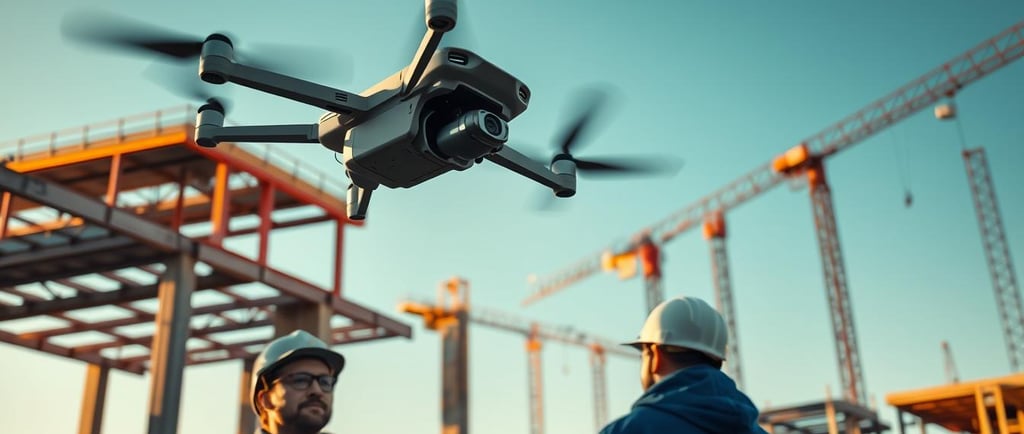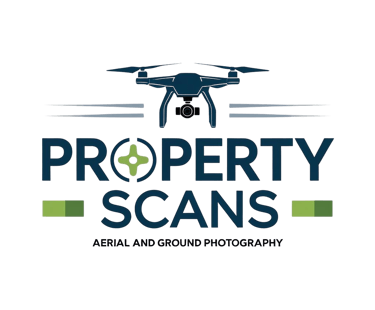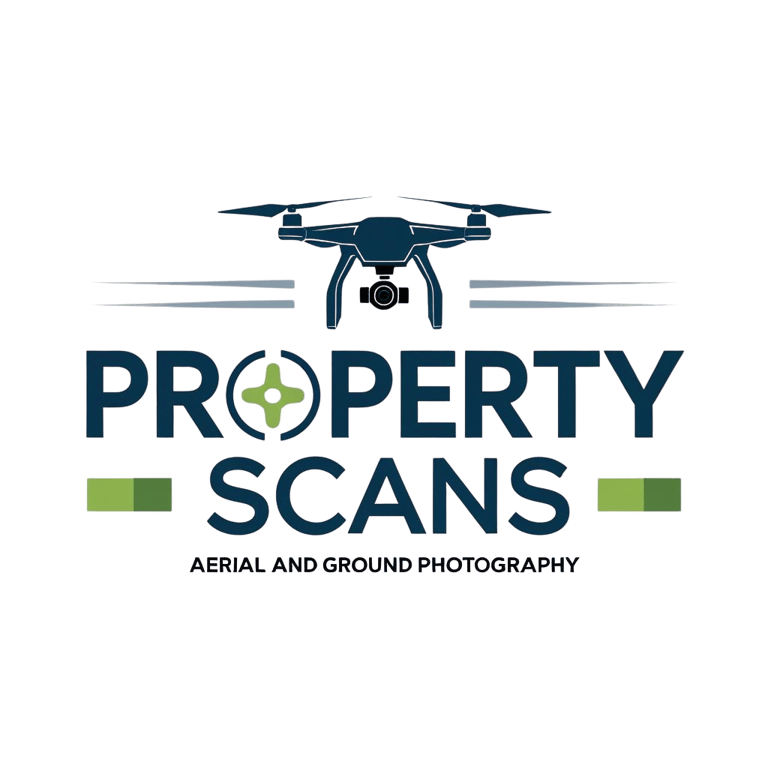How Drones Improve Safety on Construction Sites
How Drones Improve Safety on Construction Sites
AERIAL PHOTOSFIELD SERVICESCONSTRUCTION AND SAFETY
Property Scans
2/13/20258 min read


Drones for Safer Construction Sites: Enhancing Site Safety
Did you know that one in five workplace fatalities occurs in the construction industry? This alarming statistic highlights the urgent need for innovative solutions to protect workers. Enter drone technology—a game-changer in improving safety and efficiency on job sites.
During initiatives like Construction Safety Week, companies are increasingly turning to drones to reduce risks. These tools allow teams to conduct remote inspections and surveys, minimizing the need for workers to access hazardous areas. For example, Missouri’s Kuhn Construction has successfully used drones to monitor site conditions and identify potential hazards.
Beyond safety, drones offer significant benefits like cost reduction and enhanced data accuracy. They provide real-time information, helping managers make informed decisions quickly. This integration of drone technology aligns with industry standards and sets a new benchmark for safety practices.
Key Takeaways
Drones reduce the need for workers to access dangerous areas.
Remote inspections improve efficiency and accuracy.
Companies like Kuhn Construction are leading the way in drone adoption.
Real-time data helps managers make faster, safer decisions.
Drone technology aligns with industry safety standards.
Understanding the Role of Drones in Construction Safety
Safety on construction sites has taken a leap forward with drone technology. These advanced tools are now a cornerstone in reducing risks and improving efficiency. By enabling remote inspections, drones minimize the need for workers to access dangerous areas, ensuring safer operations.
Benefits of Remote Inspections
Remote inspections are a game-changer for the construction industry. Drones can access hard-to-reach areas, such as high structures or unstable zones, without putting workers at risk. This approach significantly reduces the chance of falls and other accidents.
For example, drone-mounted sensors can detect heat signatures, preventing potential fires or equipment malfunctions. Companies like Kuhn Construction have reported a 30% reduction in accidents after adopting drone inspections, according to Commercial UAV News.
Reducing Human Error and Risk
Human error is a leading cause of accidents on job sites. Drones eliminate this risk by providing accurate, real-time data. Inspections conducted from a safe distance ensure precision and reduce the likelihood of mistakes.
Traditional methods often require workers to climb scaffolding or navigate hazardous areas. Drones, however, can complete these tasks quickly and safely. This not only protects workers but also saves time and costs.
Method Time Required Risk Level Cost Efficiency Traditional Inspections 4-6 hours High Low Drone Inspections 1-2 hours Low High
By integrating drone technology, construction companies are setting new standards for safety and efficiency. The benefits are clear: fewer accidents, faster inspections, and significant cost savings.
Enhancing Construction Site Safety with Drones
Modern construction projects are leveraging drone technology to redefine safety standards. These advanced tools are not just supplements but integral components of modern safety practices. By combining traditional methods with cutting-edge drone capabilities, companies are achieving unprecedented levels of safety and efficiency.
Integrating Drone Technology with Traditional Methods
Traditional construction practices often involve manual inspections, which can be time-consuming and risky. Drones, however, are transforming this process. They provide a safer alternative by accessing hazardous areas without putting workers in danger. For example, drones equipped with infrared cameras can detect structural weaknesses or heat anomalies, preventing potential accidents.
Companies are now integrating drones into their daily operations. This hybrid approach combines the reliability of traditional methods with the precision of drone technology. The result is a streamlined process that minimizes risks and maximizes efficiency.
Technological Advancements and Hardware Capabilities
Recent advancements in drone hardware have significantly enhanced their capabilities. Features like 3D mapping and real-time data transmission allow for more accurate and timely inspections. For instance, Drone-in-a-Box solutions, as highlighted by Commercial UAV News, enable autonomous operations, reducing the need for manual intervention.
Infrared cameras and advanced sensors further improve safety by identifying hazards that are invisible to the naked eye. These tools are particularly useful for monitoring older structures, where hidden risks are more prevalent.
Method Time Required Risk Level Cost Efficiency Traditional Inspections 4-6 hours High Low Drone Inspections 1-2 hours Low High
By adopting these technological advancements, construction companies are not only improving safety but also enhancing overall project management. Staying updated with the latest drone models and software ensures that teams are equipped to handle any challenge.
In conclusion, the integration of drones into construction practices is setting new benchmarks for safety and efficiency. As technology continues to evolve, so too will the ways in which we protect workers and optimize operations.
Implementing Drone Technology for Safer Worksites
Deploying drones on job sites is no longer a luxury but a necessity for modern construction practices. These tools are transforming how teams manage risks, improve workflows, and ensure compliance with safety standards. By following a structured approach, companies can maximize the benefits of drone technology while minimizing potential hazards.
Step-by-Step Guide to Drone Deployment
Successful drone deployment begins with thorough preparation. First, ensure your team has the necessary certifications, such as FAA Part 107 for commercial drone use. Next, select the right hardware, including drones equipped with high-resolution cameras and advanced sensors for accurate data collection.
Once the equipment is ready, conduct an initial site evaluation. Identify potential hazards, such as power lines or unstable structures, and plan flight paths accordingly. This step is crucial for minimizing risks during operations.
During deployment, follow strict safety protocols. Establish clear communication channels between the drone operator and ground team. Use pre-flight checklists to ensure all systems are functioning correctly. Companies like Skygauge and Percepto Air have successfully implemented these practices, achieving significant improvements in safety and efficiency.
Regulatory and Procedural Requirements
Compliance with regulations is essential for commercial drone usage. In the U.S., operators must adhere to FAA guidelines, including airspace restrictions and flight altitude limits. Additionally, companies should develop internal policies to govern drone operations, ensuring consistency across projects.
Training is another critical component. Equip your team with the skills needed to operate drones safely and effectively. This includes understanding emergency procedures and troubleshooting common technical issues.
Step Description Outcome Certification Obtain FAA Part 107 certification Legal compliance Hardware Selection Choose drones with advanced sensors Accurate data collection Site Evaluation Identify hazards and plan flight paths Minimized risks Safety Protocols Follow pre-flight checklists Safe operations Training Equip team with operational skills Improved efficiency
By adopting a systematic approach, construction companies can enhance safety, reduce costs, and improve project outcomes. Drone technology is not just a tool but a strategic asset for modern worksites.
Improving Efficiency and Reducing Costs with Drone Surveying
Drone surveying is revolutionizing the way construction projects manage efficiency and costs. By replacing traditional methods with advanced technology, companies are achieving significant time and expense savings. This section explores how drones are transforming surveying operations and delivering measurable benefits.
Enhanced Efficiency in Survey Operations
Drones are redefining efficiency in surveying. Traditional methods often require hours or even days to cover large areas. In contrast, drones can survey up to 120 acres per hour, compared to just five acres using manual techniques. This speed allows teams to complete tasks faster, reducing project timelines.
Additionally, drones provide real-time data, enabling managers to make informed decisions quickly. This eliminates delays caused by waiting for survey results. For example, Propeller’s cloud-based software ensures data accuracy and accessibility, streamlining the entire process.
Expense Reduction and ROI Considerations
Cost savings are a major advantage of drone surveying. Traditional methods require significant labor and equipment expenses. Drones, however, reduce these costs by automating tasks and minimizing the need for manual intervention.
According to Propeller, companies using drones report a 50% reduction in surveying costs. This includes savings on labor, equipment, and fuel. The return on investment (ROI) is further enhanced by the ability to identify and address issues early, preventing costly delays.
Comparing Traditional Methods with Drone Surveying
The differences between traditional and drone surveying are stark. Traditional methods are time-consuming, labor-intensive, and often risky. Drones, on the other hand, offer a safer, faster, and more cost-effective alternative.
Method Time Required Cost Efficiency Accuracy Traditional Surveying Days to weeks High expenses Prone to human error Drone Surveying Hours Significant savings High precision
By adopting drone technology, construction companies can improve efficiency, reduce costs, and enhance overall project management. This innovative approach is setting new standards in the industry.
Optimizing Safety Through Drone-Driven Inspections and Real-Time Monitoring
The integration of drone technology is reshaping safety protocols in the construction industry. By leveraging advanced tools like 3D mapping and sensor systems, companies are identifying hazards before they escalate into accidents. This proactive approach ensures safer operations and minimizes risks for workers.
Using 3D Mapping and Sensor Technology
3D mapping is a game-changer for hazard detection. Drones equipped with laser range finders and near-infrared cameras can create detailed site models. These models highlight structural weaknesses or potential dangers, allowing managers to address issues before they become critical.
For example, thermal imaging can detect overheating equipment, preventing fires. Near-infrared cameras identify material defects invisible to the naked eye. These technologies provide accurate data, reducing the need for manual inspections in dangerous areas.
Monitoring Hazardous Areas Remotely
Drones excel at monitoring hazardous locations without exposing workers to risks. They can access unstable structures, high elevations, or confined spaces safely. Real-time video feeds and cloud-based software keep teams updated on site conditions, enabling quick decision-making.
Continuous monitoring supports proactive maintenance. For instance, drones can track changes in a site’s terrain or equipment status over time. This data helps managers implement preventive measures, reducing the likelihood of accidents.
Method Accuracy Risk Level Time Efficiency Traditional Inspections Moderate High Slow Drone Inspections High Low Fast
By adopting drone-driven inspections, construction companies are improving safety and efficiency. This innovative approach is setting new standards for the industry, ensuring safer job sites and better project outcomes.
Best Practices for Training, Certification, and Software Integration
Effective drone operations on job sites require a combination of proper training, certification, and advanced software integration. These elements ensure that teams can operate drones safely and efficiently, minimizing risks and maximizing productivity. By following industry best practices, companies can set a strong foundation for successful drone deployment.
Essential Training and Certification Requirements
Proper training is the cornerstone of safe drone operations. Operators must obtain certifications like the FAA Part 107 in the U.S., which covers airspace regulations, flight safety, and emergency procedures. This credential ensures compliance with legal standards and reduces the risk of accidents.
Continuous learning is equally important. As drone technology evolves, operators must stay updated on new features and software updates. Companies like Skygauge have implemented comprehensive training programs, ensuring their teams are always prepared for the latest advancements.
Integrating Mapping Software for Accurate Data
Advanced mapping software is essential for accurate data collection and analysis. Tools like Propeller offer real-time data processing, enabling teams to make informed decisions quickly. These platforms also support collaboration, allowing multiple stakeholders to access and analyze data simultaneously.
Integrating software into drone operations minimizes errors and enhances efficiency. For example, Propeller’s cloud-based solutions provide detailed 3D maps, helping managers identify potential hazards and plan projects more effectively. This integration ensures that data is both accurate and actionable.
By adopting these best practices, construction companies can improve safety, reduce costs, and streamline operations. Proper training, certification, and software integration are not just steps but essential components of modern drone management.
Conclusion
The adoption of drone technology is transforming how we approach safety in the construction sector. These advanced tools are no longer optional but essential for modern projects. By integrating drones, companies can significantly reduce risks, improve efficiency, and save costs.
Remote inspections and real-time monitoring are two of the most impactful applications. Drones allow teams to assess hazardous areas without putting workers in danger. This approach not only enhances safety but also speeds up project timelines.
Advanced features like 3D mapping and sensor technology further elevate safety standards. These tools detect potential hazards early, preventing accidents before they occur. For example, thermal imaging can identify overheating equipment, reducing fire risks.
Proper training and certification are critical for successful drone deployment. Operators must understand regulations and safety protocols to ensure smooth operations. Companies that invest in training see significant improvements in both safety and efficiency.
In summary, drones are revolutionizing the construction industry. They offer a safer, faster, and more cost-effective way to manage projects. For companies looking to stay competitive, adopting drone technology is a smart move.
Take the next step: Explore how drones can benefit your projects. Contact a professional today or subscribe to updates for the latest industry insights.
Additional Resources and Next Steps
To further explore the benefits of drone technology in construction, consider these actionable resources and next steps. Start by subscribing to the Commercial UAV News Newsletter for the latest updates and case studies. This will keep you informed about advancements and best practices.
For continued professional development, explore online resources and training programs. Many platforms offer courses on drone operation, certification, and software integration. These skills are essential for maximizing the efficiency and safety of your projects.
Take advantage of software trials to experience firsthand how drones can enhance your workflow. Tools like Propeller provide detailed 3D mapping and real-time data, streamlining project management.
Finally, consider joining webinars or industry events to network with experts and stay ahead of trends. Transitioning to drone-enabled solutions is a smart move for any job site. Start today and see the difference it can make.
Revolutionizing the way properties are marketed. With combination of onsite photography and AI we provide affordable services with personalized customer service.
info@propertyscans.net
© 2024. All rights reserved.


